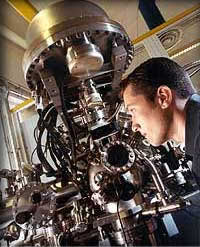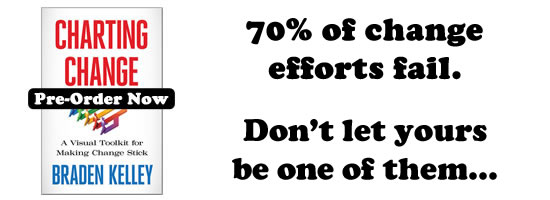What Is Innovation? Says Who?
 Innovation is a broad topic talked about in ways which confuse the subject. It’s also a subject that generates a wide range of reactions. This blog defines innovation and views it through three lenses – customer, organization, individual – to bring into focus what it might mean for you.
Innovation is a broad topic talked about in ways which confuse the subject. It’s also a subject that generates a wide range of reactions. This blog defines innovation and views it through three lenses – customer, organization, individual – to bring into focus what it might mean for you.
I like to use a definition of innovation as doing something different to add value for a customer. Innovation adds an ability to do something or know something the customer didn’t previously have.
This isn’t the only definition one can use but I like it because it keeps the focus on the customer regardless of whether they’re internal or external to an organization. It can be used to include value-add for customers and the innovating organization, which is important for investment decision making. And it means the innovating organization must become different and stay different to sustain value-add to the customer.
The Customer Perspective
Customers perceive innovation as satisfaction with something. They value an innovation if they’re satisfied with what it lets them do or know that they couldn’t do or know, before. This is true for new capabilities or improvements to existing capabilities. And it’s true for both internal and external customers.
Government customers perceive innovation as delivering on government’s mission. Government exists to do things that individuals and communities could never do, or do well, at scale. We need big things from government and express what we value in missions. Caring for Veterans. Ensuring justice. Protecting the environment. Food safety. Customers see Constitutional rights, civil rights, and basic human needs embedded in government missions and value programs which deliver on those missions.
Government consumers also perceive innovation as technology. Organizations can innovate their technology, business, and cultural models but technology innovations get noticed. A number of factors explain this: The general consumerization of information technology in our lives; faster technology adoption rates; the ubiquity of government agency Websites; greatly increased mobile computing capability; the growing number of government apps; and certain demographic shifts.
Increased customer-government interaction using technology and the general consumerization of IT create an important condition for government innovation: Customers want more. It’s human nature. If technology capability exists but we have little of it, we want some. When we have some we want more. When we’ve adopted a technology and made it part of our lives, when we stop thinking about its novelty and simply turn to it because it’s how we’ve come to do something, we want that functionality better, faster, and cheaper. Customers expect government to use technology to meet its many missions better, faster, and cheaper.
What do we see looking through this lens? Customers perceive innovation as satisfaction with being able to do or know something they couldn’t do or know, before. They value innovations which deliver government’s mission, and expect government to use technology to meet its many missions better, faster, and cheaper.
The Organizational Perspective
Organizations don’t really perceive anything. People do. But we talk about organizational culture and we can use that as a lens on innovation.
Organizational culture is the rationale for how people use knowledge and skill to support value creation and delivery. This includes assumptions, beliefs, values, norms, behaviors and more, plus the meaning people in the organization attach to these things. Defined this way, notice how organizational culture isn’t equal to organizational structure.
Parts of organizations with science and technology missions, for example, are disposed to embrace innovation because their work requires it. NOAA scientists, NASA engineers, NRO analysts, the warfighter and many more convert ideas into value for their day jobs. Testing, learning, discovery – much of the innovation experience is built into their culture and they perceive innovation as the way they get their jobs done, or done better.
Parts of organizations with less innovation embedded in training and roles can still innovate, but their perception is likely to be different. Government attorneys are conservative because their job is to keep people and organizations out of trouble. Contract officers might innovate an acquisition process but they’ll do it within the FAR because their job is to make sure everyone plays by the rules. Mid-level managers must balance creating new value with delivering existing value, and that balancing act constrains innovation.
A common perception of innovation in this camp is tension. There’s something about it that might be positive, something that might add value for customers. But there’s something about it that collides or conflicts with core job responsibilities and authorities. Given a lack of innovation definition, guidance, process, and safeguards by the organization, people in this camp will innovate tentatively, if at all.
So what do we see looking through this lens? Groups of people in organizations who share similar training, roles, and missions perceive innovation based on whether it facilitates or challenges their core job responsibilities and authorities. This creates cultures similarly oriented toward innovation and disposed to innovate, or not.
The Individual Perspective
Individuals hold the full range of perceptions, but risk orientation heavily influences them. Research tells us people are risk tolerant or risk averse by nature, and that more of us are risk averse. This tells us a lot about how individuals perceive innovation.
Perceptions of the risk averse likely include danger, skepticism, fear, stress, and more work. These individuals doubt there’s much good in innovation for them, so their orientation leans toward avoidance. Perceptions of the risk tolerant likely include new, exciting, different, refreshing, and opportunity. These people believe there is something in innovation for them, so their orientation leans toward approach.
Approachers are drawn to innovation and energized to contribute. They might ask what they could do differently to add value for the team, the project, the mission, the customer – or themselves – and find more to try than there is time to try it.
Avoiders are motivated by two things:
1. Keeping away from something negative that has not yet happened
2. Getting away from something negative which is present
If innovation is contemplated, they appear doubtful or opposed. If innovation is underway, they appear reluctant or negative. But notice the value judgment in my statements. Only approachers see avoiders in these uncomplimentary ways. To avoiders, their perceptions stand for something, not just against something.
The holder of a “negative†view views it as positive, as a commitment to something they value and wish to maintain – stability, protecting the customer, not wasting resources chasing the next shiny object, and on. Not at all unreasonable given how few organizations have clarified its meaning with regard to their mission, and that very basic questions remain unanswered: Don’t organizations already have more requirements than resources? How can one innovate when budgets are approved nine months into a fiscal year? How will innovation impact current operations? No one celebrates failure, so what happens if it doesn’t work?
Why disrupt an organization to take this on when the buzz will pass and leave us, where, avoiders wonder?
So what do we see looking through this lens? Human nature predisposes us to feel more or less comfortable taking risks. Risk orientation colors perceptions of innovation and motivates some to approach it, and some to avoid. Innovation is probably everything it’s perceived it to be, but we all probably tend to see what we’re looking for – or look for what we expect to see.
Now What?
I hope my definition of innovation and quick peeks into how it’s perceived have helped you see it differently. My goal is to help us unthink what we think we know about innovation and rethink it.
But where does this leave us? What next? Where happens next depends on where you are and where you’re headed. Here are some ideas to consider:
- For the Customer: Help your organization stay focused on the customer. Facilitate conversations about what the organization might do differently to add value for a customer or customer segment.
- For the Organization: Help your organization identify and use the views of cultures within the organization. Think Covey: Seek first to understand…
- For the Individual: Doubts and concerns signal value. Enter conversations through those points rather than around them. The goal is to hear the value and apply it, not to correct people.
Wait! Before you go.
Choose how you want the latest innovation content delivered to you:
- Daily — RSS Feed — Email — Twitter — Facebook — Linkedin Today
- Weekly — Email Newsletter — Free Magazine — Linkedin Group
 Lou Kerestesy is passionate about government. He’s worked for and with government for 30 years and believe in its mission. GovInnovators is an innovation consulting firm focused on making innovation simple so clients can work from the inside out – initiating and managing their own innovation efforts and growing capability, fast.
Lou Kerestesy is passionate about government. He’s worked for and with government for 30 years and believe in its mission. GovInnovators is an innovation consulting firm focused on making innovation simple so clients can work from the inside out – initiating and managing their own innovation efforts and growing capability, fast.
NEVER MISS ANOTHER NEWSLETTER!
LATEST BLOGS
Starbucks and Big Tobacco
Back in the 1950’s smoking was glamorous, and just about everybody who was anybody smoked cigarettes. Then came the discovery, to the shock of millions, that sucking smoke into your lungs might not be good for you. Then came another revelation that one of the substances in tobacco, nicotine, which was used as a poison by the Egyptians during the times of the Great Pyramids, is addictive. People then began a mass exodus from the consumption of nicotine via inhaled smoke.
Read MoreWal-Mart Goes Green – What about your company?
With the price of gas above $3.00, some companies (and hopefully all) are beginning to look at the fuel efficiency of their fleets. Wal-Mart is the most public example of this with its trucking fleet. Its efforts include:
Read More



